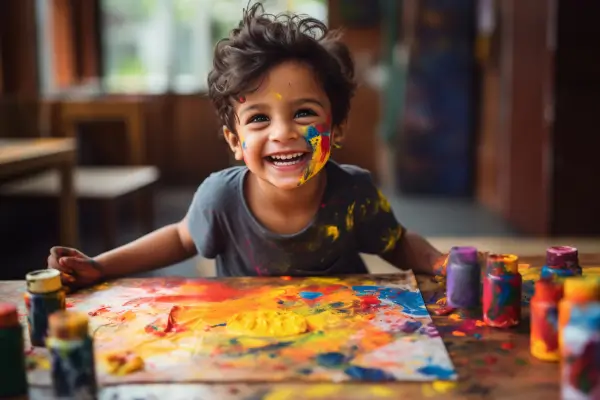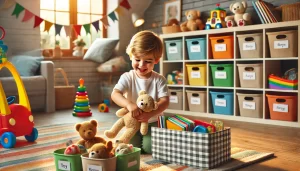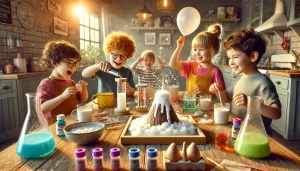Creativity is one of the most important skills a child can develop. It helps with problem-solving, critical thinking, and emotional expression. Encouraging creativity at home doesn’t require expensive materials or complex projects. Simple and engaging activities can spark imagination and allow children to explore their ideas freely.
In this article, we will explore 10 fun and educational activities that will stimulate children’s creativity at home. These activities are designed to be hands-on, enjoyable, and beneficial for their cognitive and emotional growth.
Storytelling with a Twist
Storytelling is a fantastic way to encourage creativity, language skills, and imagination. Instead of reading a book in the usual way, try these interactive storytelling techniques:
- Story Dice: Create dice with different pictures or words. Roll them and use the results to build a story together.
- Alternate Endings: Read a familiar story and ask your child to come up with a different ending.
- Story Chain: Take turns adding one sentence to a story to see how it develops in unexpected ways.
These engaging activities encourage children to think creatively and develop problem-solving skills by exploring new perspectives. At the same time, they enhance vocabulary acquisition, strengthen narrative abilities, and foster confidence in self-expression.
DIY Art and Craft Station
Set up a dedicated area for arts and crafts where children can freely express their creativity. Include items such as:
- Colored paper, glue, scissors, and stickers
- Recycled materials like cardboard boxes, bottle caps, and old magazines
- Washable paints and brushes
Give your child the freedom to create without rigid guidelines, allowing their imagination to take the lead. The goal is to encourage exploration, self-expression, and creativity rather than striving for perfection. Support their artistic journey by providing materials and inspiration while letting them take ownership of their projects.
Indoor Treasure Hunt
A treasure hunt is an exciting way to boost creativity and problem-solving skills. Here’s how to organize one:
- Write a series of clues that lead from one location to another.
- Make the clues rhyme or turn them into riddles.
- Place small prizes or surprises at the final destination.
To add an educational twist, design the hunt around engaging themes like science, math, or history. For example, include clues that require solving simple math problems, identifying historical figures, or discovering fun science facts. This not only makes the activity more interactive but also reinforces learning in a hands-on, exciting way.
Puppet Show and Role-Playing
Encourage dramatic play by setting up a puppet show or engaging in role-playing activities. You can:
- Use old socks to create sock puppets.
- Make paper bag puppets with drawn faces.
- Act out a favorite story or invent a new one.
Role-playing is a powerful tool for child development, fostering communication skills, emotional intelligence, and self-confidence. By stepping into different roles, children learn to express themselves more effectively, understand various perspectives, and navigate social interactions with greater ease.
Music and Dance Time
Music is a powerful tool for creativity. Let children explore music in fun ways:
- Create homemade instruments using household objects (pots, spoons, or rubber bands on a box).
- Make up silly songs together based on daily activities.
- Dance challenge: Play different types of music and encourage them to move in ways that match the rhythm.
Music and movement engage multiple areas of the brain, enhancing cognitive development, coordination, and self-expression. Rhythmic activities help children improve motor skills, balance, and spatial awareness while also strengthening memory and language abilities.
Science Experiments with Everyday Materials
Science experiments are a great way to blend creativity with learning. Here are some simple ideas:
- Magic Milk Experiment: Add drops of food coloring to a plate of milk, then touch it with a cotton swab dipped in dish soap and watch the colors swirl.
- Volcano Eruption: Mix baking soda and vinegar in a small container for a fun fizzy reaction.
- Invisible Ink: Use lemon juice as ink and reveal the message by holding the paper near a lightbulb.
These experiments ignite children’s natural curiosity, fostering a sense of wonder and exploration. By engaging in hands-on activities, children learn to ask questions, form hypotheses, and analyze results. This process nurtures critical thinking skills, as they evaluate outcomes and make connections to the real world.
Build a Mini City with Recycled Materials
Encourage hands-on creativity by building a small city using items from around the house. Use:
- Shoeboxes and cardboard for buildings
- Toy cars and figures for decoration
- Paper towel rolls for towers
Ask your child to design roads, parks, and houses, stimulating their spatial awareness, creativity, and problem-solving skills. This activity allows them to visualize and plan structures, helping to improve their understanding of layout and proportion. As they map out their designs, children practice organizing space efficiently and consider how different elements interact with each other.
Nature Art and Outdoor Exploration
Take creativity outside by exploring nature-based activities:
- Collect leaves and flowers to create nature collages.
- Make rock paintings with funny faces or patterns.
- Press flowers and leaves in a book to create nature-inspired bookmarks.
These activities connect children with the environment while boosting artistic expression by encouraging them to draw inspiration from nature. As children engage with their surroundings—whether it’s observing the colors of a sunset, the shapes of trees, or the texture of leaves—they develop a deeper appreciation for the world around them.
Creative Writing Challenge
Writing is an excellent way to express thoughts and ideas. Try fun writing activities like:
- Comic Strip Creation: Draw a comic strip with characters and speech bubbles.
- “What If?” Stories: Ask imaginative questions like, “What if animals could talk?” and write a short story about it.
- Word Jars: Pick random words from a jar and make up a story using them.
Encouraging children to write freely enhances their literacy skills and self-expression by giving them the freedom to explore their thoughts, ideas, and emotions without the constraints of formal rules. When children are allowed to write creatively, they develop a love for words and storytelling, building their vocabulary and understanding of grammar in a natural, enjoyable way.
Cooking as a Creative Activity
Cooking is an exciting way to engage children’s creativity while teaching valuable life skills. Let them:
- Invent a new sandwich or smoothie by mixing different ingredients.
- Decorate cupcakes or cookies in unique designs.
- Create a “mystery recipe” by choosing three random ingredients and making a dish.
Cooking enhances creativity, fine motor skills, and problem-solving abilities by engaging children in hands-on activities that require both imagination and critical thinking. As they experiment with different ingredients, flavors, and textures, children tap into their creative instincts to come up with unique dishes or modify recipes. This process allows them to visualize and explore new ideas, encouraging an innovative approach to tasks.
Final Thoughts
Encouraging creativity at home doesn’t require fancy tools or structured lessons. The key is to provide opportunities for imaginative play, hands-on activities, and open-ended exploration.
By incorporating these 10 fun and educational activities, you’ll help your child develop critical skills while making learning enjoyable. Try one of these activities today and watch their imagination flourish!




